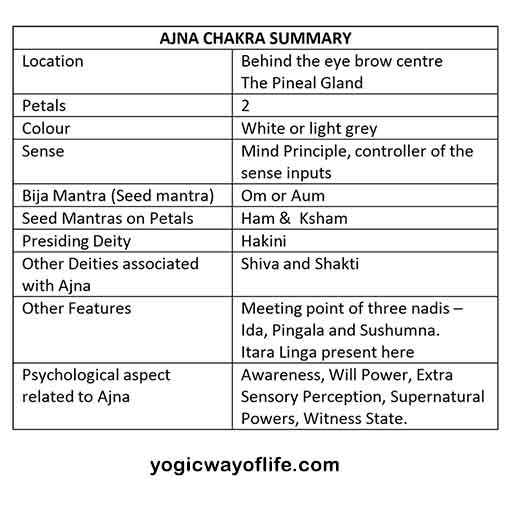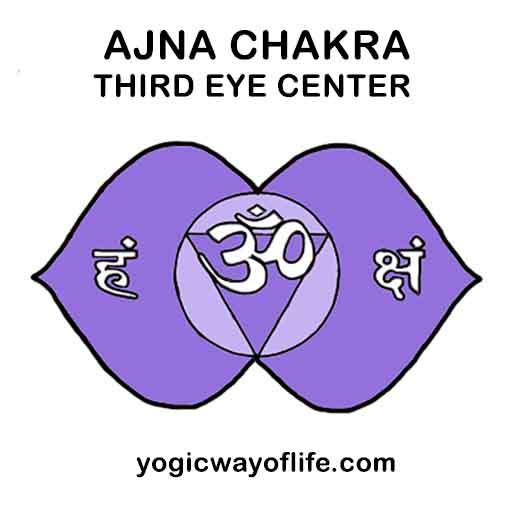Ajna Chakra or the third eye centre is an important chakra in the spiritual evolution. In Sanskrit, Ajna means command or monitoring centre, and Chakra means a wheel or vortex or energy. Ajna Chakra or the third eye centre is the place where the three main Nadis or meridians Ida, Pingala and Sushuma merge and flows upwards. At this centre, there is a merging of consciousness and the individual ego can be transcended to experience Samadhi. According to tantric texts, there are seven chakras or plexuses. Ajna is the sixth and a very significant chakra.
Location of Ajna Chakra
Ajna chakra is located behind where the two optic nerves cross over, on top of the spinal column, just behind the Medula Oblongata. The Pineal gland is considered the seat of Ajna chakra. The eye brow centre between the two eyes can be considered the trigger point to activate this chakra. The pineal gland functions when we are young, but by the time we reach puberty, it begins to calcify and becomes dysfunctional. It is said that with yogic practice of Shambhavi mudra and Trataka, the Ajna chakra can be reactivated.

Traditional symbolism of Ajna Chakra
In tantra, every chakra is depicted as a flower with many petals. There are many texts that describe the Ajna Chakra. The most vivid among them is the Shad Chaka Nirupana, which has been translated to English by Sir John Woodroffe in his book, The Serpent Power.
Ajna Chakra is described as a flower with 2 petals. The petals are white or light grey in colour. On the petals are found the seed letters Ham and Ksham written in silvery white colour. Ham and Ksham represents Shiva and Shakti respectively.
Just below the chakra, the three nadis Ida, Pingala and Sushumna merge. In the centre or pericarp of the flower is a round dark circle, which represents void or Shoonya. Inside it is an inverted triangle representing Shakti. Above the triangle is a black Siva lingam. It is called Itara Lingam.
Within the triangle of the chakra, there is the combination of letters that represent Omkara or the primoidal sound Om. It is described as pure intellect or Buddhi or the inner Self and resembles a flame in its radiance. Above it is the half crescent moon and above it the Makara in the form of Bindu.
In the petals is also the deity of the Ajna Chakra called Hakini. She has six faces like the moon. In her six hands she holds a book, a skull, a small book, a rosary and other two hands show the gesture of granting boons and dispelling fear. She is described as Shuddha-Chitta or pure minded.
Ajna symbolises the Manas Tattva or principle of mind.
Seed Mantras associated with Ajna Chakra
Seed Mantras or Bija Mantras are one letter syllabled mantras with hidden power. The mantra for Ajna Chakra is Om or Aum. Practitioners use the repetition of this seed mantra to activate the chakra.
Apart from this, the petals of the chakra also have seed letters associated with it. The petals of Ajna chakra has these 2 letters – Ham and Ksham written on it. These are also used by practitioners while visualising the chakra.
Presiding Deity of Ajna Chakra
Each chakra has a presiding divinity or deity, also known as Chakradhistadhatri. Goddess Hakini is the presiding deity of Ajna. She has six faces like the moon. In her six hands she holds a book, a skull, a small book, a rosary and other two hands show the gesture of granting boons and dispelling fear. She is described as Shuddha-Chitta or pure minded.
Sense Organ connected with Ajna Chakra
In tantra, Ajna Chakra is not related to any particular sense organ, but indicates the mind principle, which manages all the sensory inputs.
How to Activate Ajna Chakra?
There are many ways of activating a Chakra or plexus. One way is the use of Bija Mantras (One syllabled sacred sounds). The bija Mantra of Ajna Chakra is Om. Chanting of the seed syllable Om, while concentrating on the eyebrow centre can be used to activate Ajna chakra.
Another way is to do Anulom Vilom Pranayama or alternate nostril breathing. This balances the Ida and Pingala Nadi. Since the Ajna Chakra is the place where these Nadis meet.
Shambhavi Mudra or eye brow centre gazing, with chanting of Om can also activate the Ajna chakra.
Another method is Trataka or fixing the gaze a one point like a candle flame or a dot on wall, etc.
Apart from these, there are tantric methods of visualisation and meditation of the chakra to develop the full potential of the plexus.
Ajna Chakra and Rudra Ghranti
Ajna is a very important centre in the evolution of man. It is connected to development of awareness. Ghranti means a knot. Rudra Ghranti or the knot of Shiva has to do with thought patterns. Ajna chakra gives extrasensory perception and many supernatural powers according to one’s inherent Samskaras or impressions in unconscious mind. The practitioner can get attached these newly developed powers. This knot represents the attachment to these powers. To progress further, the yogi has to get rid of his attachment to these powers.
Ajna and Chakra Psychology
Each plexus is associated with the quality of the mind and the evolution of the person. Ajna indicates the development of awareness. If one is fully aware in every action whether it is eating, talking, walking, etc. then the Ajna chakra is active. Awareness is the first step to overcome the inherent inner tendencies or Samskaras, which when transcended, lead to liberation and higher states of Samadhi.
Ajna is also the witness centre. Here one can observe all the mental activities, without getting involved in it. Through witnessing, we can purify the mind and overcome our inner mental defects of anger, lust, jealousy, pride, greed and delusion. This witness state helps to go beyond the ego and to achieve Samadhi.
When the third eye centre is activated, it removes the fickleness of the mind. The mind is more focussed and not scattered. This gives strength to the mind and increases the Sankalpa Shakti or the will power.

